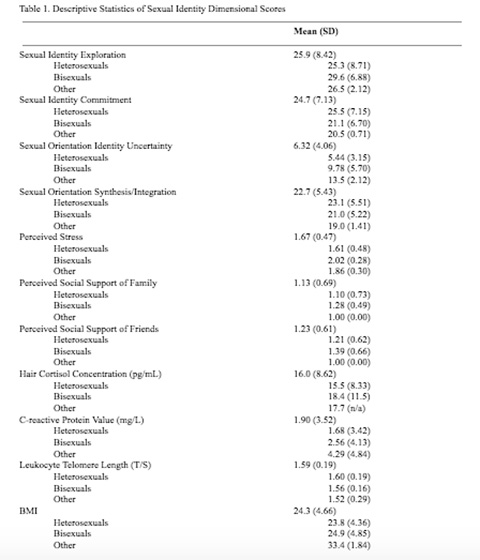Teresa Travnicek's Project
Health Indicators in Sexual Identity Development: An Exploratory Study of Sexual Identity, Stress, Social Support, and Biomarkers in First-Year College Students

Among the domains of identity which develop during adolescence and throughout life is sexual identity. Sexual identity, a multifaceted construct, can be understood as a set of understandings based on elements including sexual attractions, behaviors, and desires which integrate to comprise an individually and socioculturally salient sense of one’s sexuality (Savin- Williams, 2011). Currently, millennials comprise the fastest growing cohort of the U.S. sexual minority population (The Williams Institute, 2019). Minority stress theory (Meyer, 2003) describes processes of sexual minority stress largely driven by social factors such as discrimination and stigma which add onto existing life stress (Bränström et al., 2016). Through this framework, the prevalence of stress-related health disparities among sexual minority communities can be understood. However, the transition to college is a period during which sexual identity development involves variable and increasing exploration, flexibility, and reflection for both heterosexuals and nonheterosexuals (Thompson & Morgan, 2008; Stevens, 2004). Thus, continued exploration of the role of stress within heterosexual and sexual minority sexual identity development frameworks is imperative. The present study sought to provide an exploratory assessment of between-group differences and associations between sexual identity developmental dimensions, health indicators, and perceived stress and social support in a mixed heterosexual and nonheterosexual emerging adult sample. BMI and biomarkers of stress and immune functioning were included to capture a range of health dimensions. Initial hypotheses were formulated based on minority stress theory (Meyer, 2003), dimensions of ethnic and racial identity development (Yip et al., 2019), and literature documenting college as a critical time of sexual identity development (Stevens, 2004).
Sixty-four first-year undergraduates in their first two weeks at Fordham University were recruited to participate in the Fordham University Sleep Study, organized by the Youth Development in Diverse Contexts Lab led by Dr. Tiffany Yip, in August of 2019. 53 participants (83%) identified as heterosexual, nine (14%) as bisexual, and two (3%) with an unspecified nonheterosexual identity. Participants completed a survey including the Measure of Sexual Identity Exploration and Commitment (MoSIEC) (Worthington et al., 2008), Perceived Stress Scale (PSS) (Cohen et al., 1983), and the Multidimensional Scale of Perceived Social Support (MSPSS) (Zimet et al., 1988). The MoSIEC was utilized to assess four dimensions of sexual identity development: sexual identity exploration (M = 25.9, SD = 8.43), commitment (M = 24.7, SD = 7.13), synthesis/integration (M = 22.7, SD = 5.43), sexual orientation identity uncertainty (M = 6.32, SD = 4.06). The PSS was used to capture perceived stress over the past month (M = 1.67, SD = 0.47) and the MSPSS to assess perceived family (M = 1.13, SD = 0.69) and friend (M = 1.23, SD = 0.61) social support. Participants submitted biological and anthropometric data- including height, weight, dried blood spots, and hair samples- which were analyzed for BMI (M = 24.3, SD = 4.66), hair cortisol (M = 16.0 pg/mL, SD = 8.62) and C-reactive protein (M = 1.90 mg/L, SD = 3.52 mg/L) concentrations, and leukocyte telomere length (M = 1.59 T/S, SD = 0.19 T/S). SPSS was used to conduct one-way ANOVA, Pearson correlation, and linear regression analyses to assess associations between variables and differences between heterosexuals and nonheterosexuals.
Findings partially confirmed hypothesized differences between sexual orientation identity groups and associations between sexual identity development dimensions, perceived stress, perceived social support, and health indicators. Perceived stress was greater for bisexuals compared to heterosexuals. Unspecified nonheterosexuals showed higher BMI compared to bisexuals and heterosexuals. Sexual orientation identity uncertainty was higher for nonheterosexuals than heterosexuals. Perceived stress was associated positively with sexual orientation identity uncertainty and negatively with sexual identity commitment and synthesis/integration. Sexual identity synthesis/integration was found to negatively predict perceived stress and was negatively associated with BMI. Family social support was negatively associated with sexual orientation identity uncertainty and sexual identity exploration, as well as positively associated with hair cortisol concentration- in the opposite direction of hypotheses. See Tables 1 and 2.
Overall, this study captured a snapshot of sexual identity development, perceived stress, biomarkers, anthropometric assessments, and perceived friend and family social support for emerging adults at the beginning of the transition to college. While some such initiatives have emerged (Hall et al., 2019), findings suggest that nonheterosexual emerging adults may benefit from additional supports and interventions to promote coping skills and health behaviors and facilitate navigation of elevated perceived stress. Future research should continue to investigate health indicators and emerging adult sexual identity development with wider samples representative of diverse sexual orientation groups to promote generalizability of results.